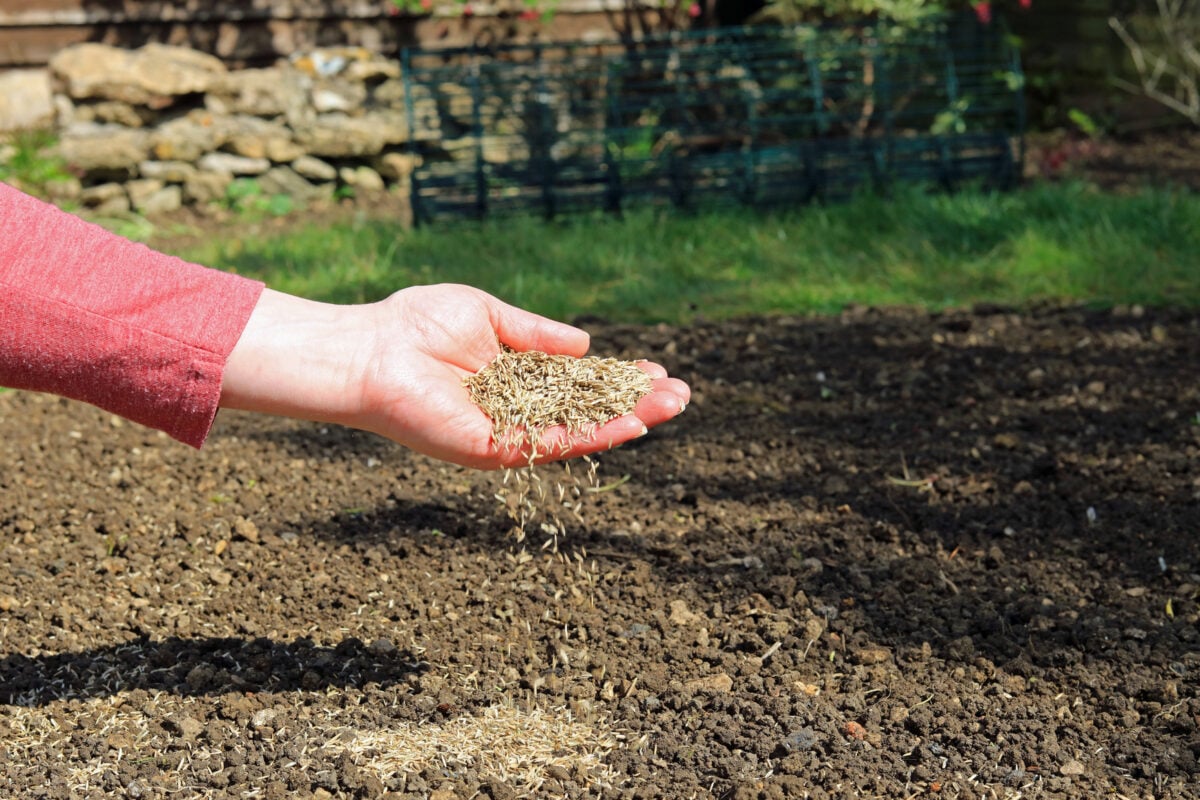The island fox only lives on six of the eight Channel Islands off the coast of Southern California. This one is shown on Santa Rosa Island in Channel Islands National Park/Jennifer Bain
On an uninhabited island off the coast of Southern California where pygmy mammoths once roamed, I trekked along sandstone cliffs and up a steep footpath into one of the rarest native pine forests in the United States. Dwarfed and gnarled by the fierce winds, the endangered evergreens with freakishly large pine cones were so mesmerizing that I almost missed seeing a fox that is found nowhere else on earth.
The island fox is one-third smaller than its mainland ancestor, the gray fox, and about the size of a house cat. Unlike nocturnal gray foxes, which hunt at night to avoid predators, island foxes don’t have natural predators and so are active during the day.
We were hiking on Santa Rosa Island and had just planted ourselves on the forest floor for lunch when a fox showed its distinctive black, white and reddish-brown face. It tolerated photos for a few minutes before disappearing into the pines. It was no pygmy mammoth but it is apparently the largest native terrestrial mammal that lives here now.

Leigh Baker Work, a naturalist with Lindblad Expeditions, hikes Torrey Pines Trail on Santa Rosa Island in Channel Islands National Park in California/Jennifer Bain
There’s a reason that Santa Rosa and the other seven Channel Islands that make up this isolated archipelago are called “North America’s Galápagos,” and it’s not because they’re teeming with giant tortoises, marine iguanas and blue-footed boobies or because they inspired Charles Darwin’s theory of evolution by natural selection.
It’s because of their rich, albeit less showy, biodiversity.
Named for the deep troughs that separate them from the mainland, the Channel Islands and their encircling waters are home to roughly 2,000 species of animals and plants — including 145 that are endemic and only found here.

Lindblad Expeditions’ National Geographic Quest anchors off Santa Rosa Island, part of Channel Islands National Park. Giant coreopsis flowers are shown in the foreground/Jennifer Bain
I’m drawn to islands, the more remote and the harder to get to the better.
I wound up on Santa Rosa during a four-night journey through the Channel Islands with Lindblad Expeditions called “Wild California Escape.” Using the 100-passenger National Geographic Quest as our home base to sleep and eat, we explored three islands that are part of Channel Islands National Park and one that is not.
Lindblad partners with National Geographic to inspire more people to care about the planet. So when we left the Port of Los Angeles in April, it was on a nimble ship with a fleet of Zodiacs and a staff of natural history and photography experts.

Kerry Deaver was one of Lindblad’s expedition drivers when guests left the National Geographic Quest to explore on Zodiacs/Jennifer Bain
“I want you to get off the ship as much as possible and do things as much as possible,” expedition leader and naturalist Oren Frey told us. “There is beauty lurking everywhere and I hope you look around. Savor being here now. This is really the California of yesteryear.”
We didn’t stray too far from the mainland, but gone was any trace of the 18 million people who pack Greater Los Angeles. Just 328,747 people visited the five islands that make up Channel Islands National Park in 2023. Most people I know have never heard of it. We would see just a handful of fellow adventurers during our visits.
Established in 1980, the park encompasses Santa Rosa, Anacapa, Santa Cruz, San Miguel and Santa Barbara islands plus one nautical mile of surrounding ocean environment. The protection extends six nautical miles with a National Marine Sanctuary. Three Channel Islands — Santa Catalina, San Nicolas and San Clemente — aren’t part of the park.

A map of Channel Islands National Park shows the five islands under the National Park Service’s care, and their proximity to Santa Barbara on the mainland of California/Jennifer Bain
The islands have distinct personalities and are only accessible by boat. There’s one established campground on each of the park’s islands, but most people visit as daytrippers to hike, picnic, birdwatch and perhaps take guided kayak trips.
Crossings can be rough and swells forced our captain, Paul Figuenick, to adjust our route. Instead of finishing on busy Catalina — the only island with hotels and a permanent population — we started on it.
“An expedition means we’re not tied to an itinerary,” Frey reminded us. “We’ll celebrate whatever we’re able to see. There is so much beauty out there — not just charismatic megafauna.”

On Catalina Island in late April, these by-the-wind sailors were washed up on a beach/Jennifer Bain
We anchored off the island’s wild backside, took Zodiacs to shore in Little Harbor and divided into hiking groups with Lindblad’s expedition team.
The beach was littered with Velella velella — clear gelatinous creatures with a tinge of blue and sail-like fins. Winds and currents have caused scores of these “by-the-wind sailors” to wash up on California shores this year.
Catalina’s sub-species of island fox was nowhere to be found but naturalist Leigh Baker Work pointed out evidence of its existence, saying “in Yellowstone we have bear-proof trash cans but here we have fox-proof trash cans.” When we spotted a lone bison grazing on a hill above the campground and beach, Work shared the unusual back-story.
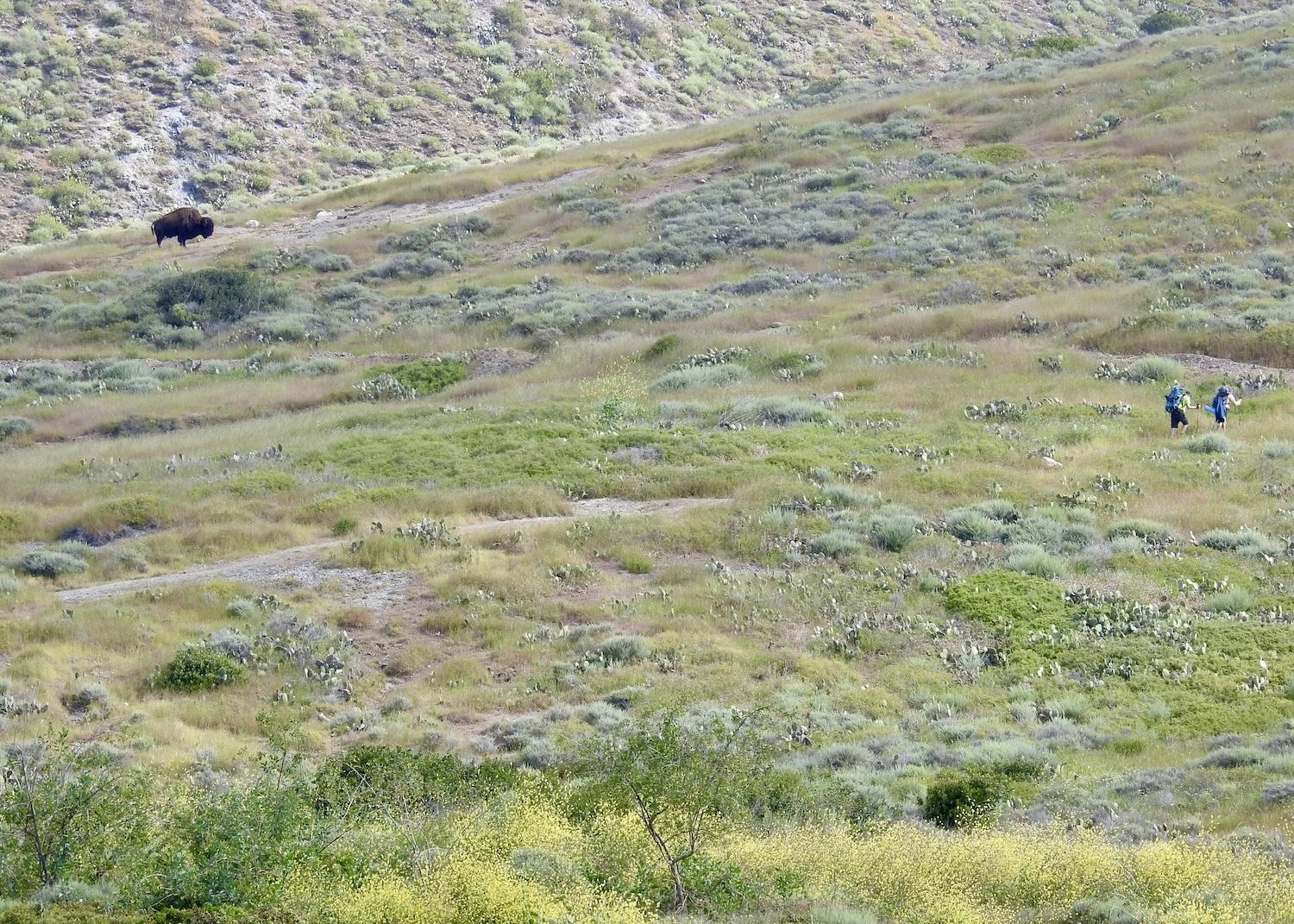
Bison roam Catalina Island, which is one of the Channel Islands but not part of Channel Islands National Park/Jennifer Bain
Legend has it that something like 14 bison were brought over in the early 1920s for a silent Western film based on Zane Grey’s The Vanishing American or The Thundering Herd. But they didn’t make it into the final cut and were left to stay and proliferate to destructive levels. The Catalina Island Conservancy eventually relocated some bison, introduced birth control, and brought the herd down from about 600 to 150.
As we walked, Work identified everything from brittlebush and prickly pear cactus to Northern mockingbirds, and reminded us to avoid poison oak and do tick checks.
We learned that the Chumash and Gabrielino-Tongva peoples managed and treasured the Channel Islands for more than 13,000 years, trading with the mainland and creating shell bead currency. European settlers brought diseases like smallpox to their communities and forcibly resettled them to the mainland, where they still thrive.
The Channel Islands became the stomping ground of Spanish explorers, missionaries, ranchers and even the military. Catalina was the haunt of smugglers, gold diggers, pirates and hunters before chewing gum tycoon William Wrigley Jr. transformed it into a resort destination in the 1920s.
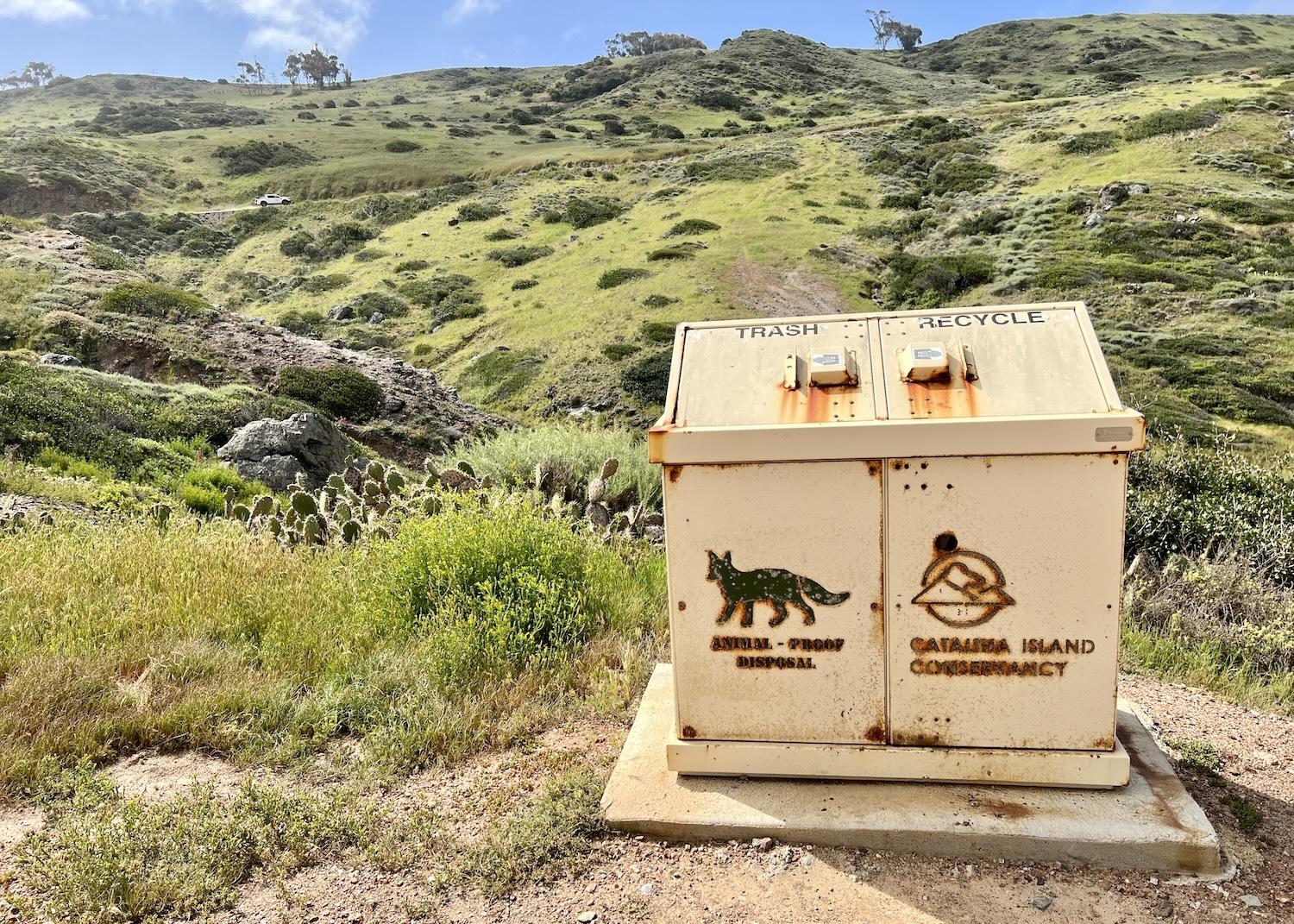
Fox-proof trash bins can be found on Catalina Island thanks to the Catalina Island Conservancy/Jennifer Bain
The Wrigley family also, to its credit, established the Catalina Island Conservancy in 1972 to protect nearly 90 per cent of the island. We saw work the conservancy is doing to restore coastal bluff scrub before moving on to Avalon, a tourist town of about 4,000 people.
Bypassing the crowded cafés and shops, I strolled over to the Catalina Casino, an Art Deco marvel, and found shore divers exploring Casino Point Underwater Park under the watchful eye of a Great blue heron. I looked in vain for garibaldi, California’s bright orange state marine fish.
The Channel Islands lie in a region between the mainland coast and the deep ocean known as the Continental Shelf where the sea floor is made up of canyons, sea mounts, banks, escarpments and deep basins. “This topography — shallow and deep, smooth and rugged, sunlit and dark — creates habitats for many species,” the National Park Service explains.

California sea lions frolic on a sunny April day on and off Anacapa Island/Jennifer Bain
The islands were never connected to the mainland, and some once formed a super island.
A mix of cold and warm ocean currents play a key role in the biodiversity here. Upwelling nutrients from the ocean floor mingle with the currents mixing fish and other sea life into what the Park Service calls “a living soup.” Giant kelp forests encircle the islands and feed everything from tiny plankton to giant blue whales.
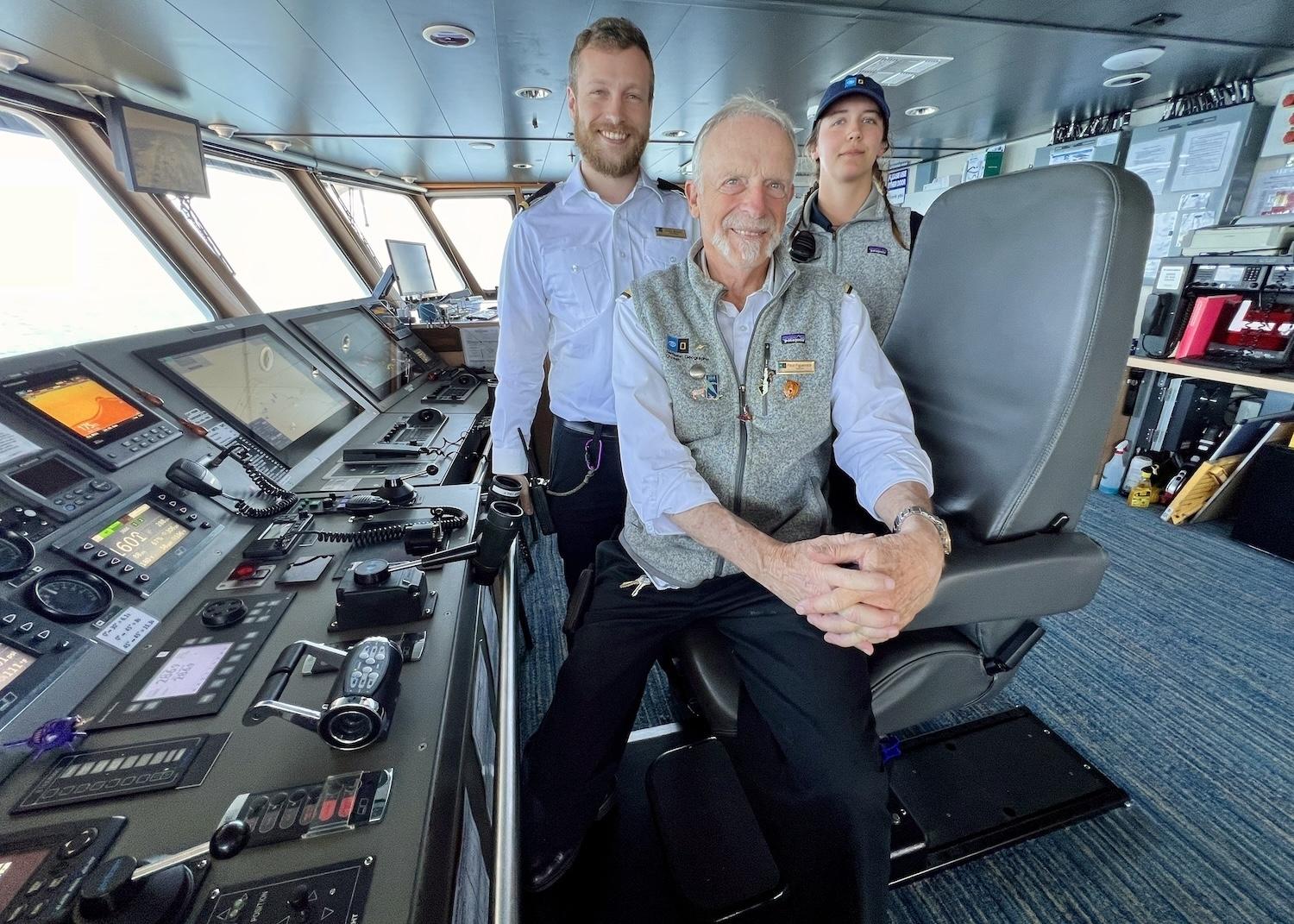
Lindblad’s National Geographic Quest has an open bridge policy so you can meet Third Mate Colby Brown, Captain Paul Figuenick and Deckhand Grace Welliver/Jennifer Bain
Wind scuttled our chance of kayaking and the whales weren’t out, but a pod of dolphins cruised alongside our ship during one meal to everyone’s delight.
I was traveling with the kind of cruisers who have “save our oceans” and “science not silence” slogans on their shirts and ball caps. We appreciated hearing Oren acknowledge that Lindblad burns a significant amount of diesel bringing people to wild places and went carbon neutral in 2019 offsetting all emissions from it ships, land-based operations, employee travel and offices.

Anacapa Island’s iconic Arch Rock is a big draw for photographers/Jennifer Bain
On the morning earmarked for Anacapa Island — three narrow volcanic islets named for the Chumash word anyapakh, which means mirage — the sea state was “excited” with “breaking swells.” That meant we couldn’t safely climb from Zodiacs up a steel-rung ladder to a dock that would lead to another 157 steps to the top of the cliff island.
Expedition cruisers must go with the flow, so instead of hiking an island that’s considered essential nesting and feeding grounds for seabirds, we pivoted to Zodiac cruises along the protected south shore.
As the fog lifted and the iconic Arch Rock came into view, we were treated to a rainbow that we dubbed a “fogbow.” We lost track of all the California sea lions — charismatic megafauna to be sure — nonchalantly floating on their backs or lounging on rocks. We gaped at the largest brown pelican rookery in the U.S. and learned how these snuggly birds were once listed as endangered when DDT (an insecticide used in agriculture) threw off their ability to absorb calcium and made their eggs shells thinner and more prone to breaking.
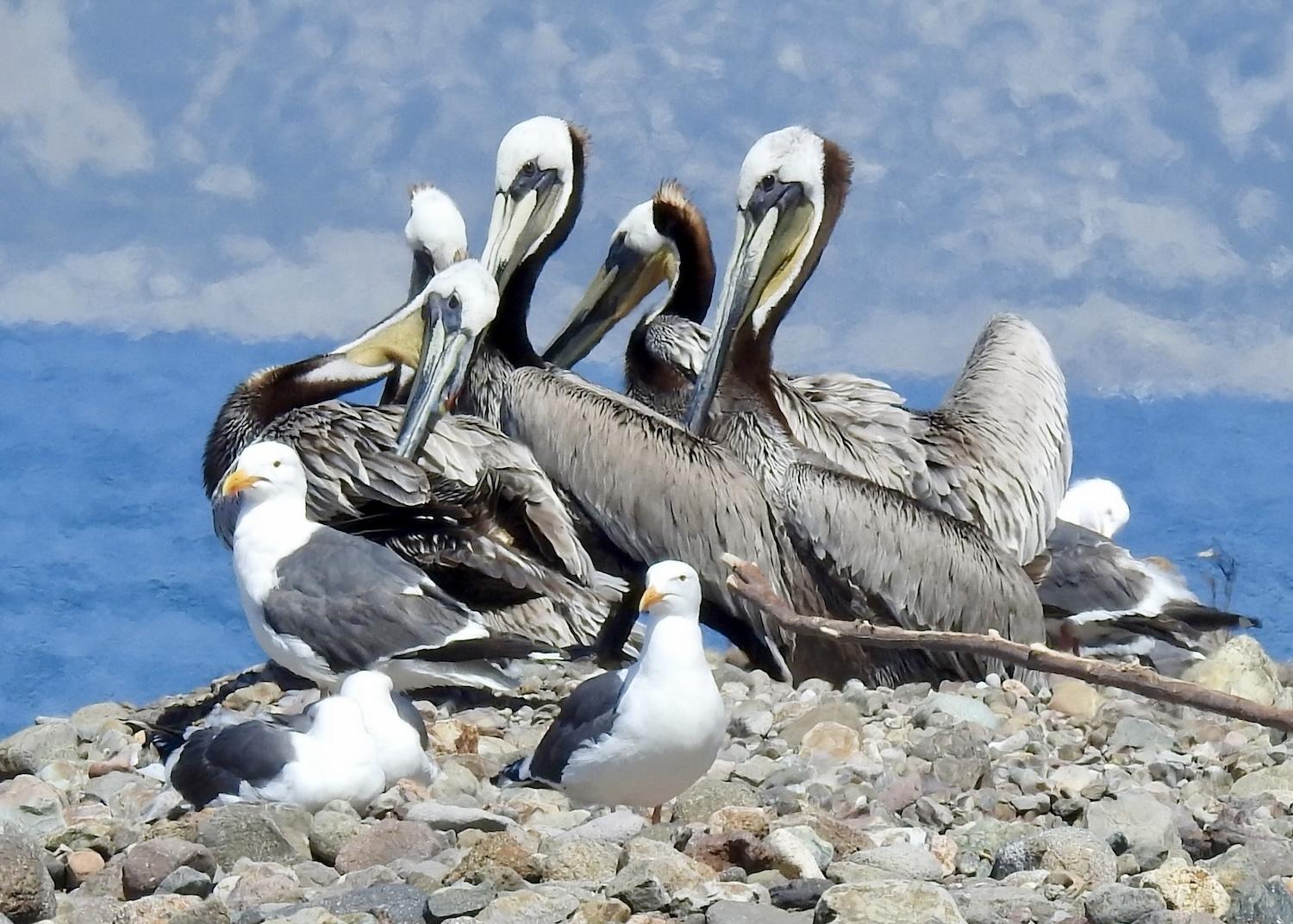
California brown pelicans relax with gulls on Santa Cruz Island/Jennifer Bain
Our final island was Santa Cruz, home of a restored wetland and the Island scrub jay. While other species shrank to adapt to this isolated and semi-arid environment, this jay grew one-third larger than its mainland counterparts and became a darker blue with a beefier beak. This natural phenomenom is called gigantism.
The jays stayed hidden so I refocused on another squadron (or is it pod?) of pelicans and the gorgeous and abundant Giant coreopsis. The poster-child of the Channel Islands has bright yellow, droopy, daisy-like petals and a Dr. Seuss-like vibe.
“Flowers make us happy, and I still don’t know if I can explain why,” mused naturalist Andy Putnam. The flowers were indeed a joy to photograph, unlike those rare Torrey pines on Santa Rosa whose gnarly beauty was better enjoyed in real life.

A “river” of Torrey pine cones has formed on a hill on Santa Rosa Island/Jennifer Bain
Torrey pines only grow naturally here and near San Diego. Nobody knows whether seeds were brought over from the mainland by birds or by the Chumash or their ancestors. But after thousands of years of isolation, the Santa Rosa Island Torrey pine grows shorter, broader and bushier than the mainland one, and has thicker and scalier bark and rounder cones.
More memorable than the trees, to be honest, was the “river” of pine cones I spotted while making my way back down a steep section of forest.
Anyway, the Park Service says the Torrey pines are doing well and so are the island foxes that were once predated to near extinction by golden eagles. That happened when DDT caused a decline in bald eagles and the golden eagles swooped in to feast on non-native feral pigs and mule deer fawns.

Hiking and birding on Santa Cruz Island in Channel Islands National Park/Jennifer Bain
When we returned to the ship after visiting Santa Rosa and gathered for recap, Putnam challenged us to describe our day in three words.
“Windy, wet, wonderful,” enthused one guest.
“Foxes, flowers, fun,” offered another.
“Mega-cones, man, mammoths,” I should have said.

The rare Torrey pines of Santa Rosa Island create extra-large cones/Jennifer Bain
Mega-cones I saw plenty of, but the man in question and the mammoths were long gone.
Possibly the oldest human remains in North America were discovered on Santa Rosa in 1959. The bones of the 13,000-year-old “Arlington Springs Man” have now been repatriated by the Santa Barbara Museum of Natural History to the Santa Ynez Band of Chumash Indians for reburial.
Pygmy mammoth remains were discovered in 1994 sticking out of an eroding bluff in what proved to be the world’s most complete fossil of this species. That mammoth was 5.5 feet tall and 2,000 pounds — much smaller than his Columbian mammoth ancestors — when it died nearly 13,000 years ago.
Hiking to the Torrey Pine forest and back that day, I knew I was walking in the steps of everyone and everything that roamed this precious land before me.
While You’re Exploring The Channel Islands:

At the Santa Barbara Botanic Garden, botanist/plant systematist Matt Guilliams shows off Giant coreopsis, a popular sight on the Channel Islands/Jennifer Bain
“After our time exploring wild places out on the islands, we will have to readjust to the density of city life,” a farewell note said as Lindblad’s Wild California Escape expedition ended. But I wasn’t ready to let the Channel Islands go, so I bypassed L.A. and hopped a train for Santa Barbara, the laid-back “American Riviera.”
At the Santa Barbara Botanic Garden, botanist/plant systematist Matt Guilliams gave me a behind-the-scenes tour of the conservation seed and tissue bank and the genetics and multipurpose labs. “Seed banking is a fantastic, low-impact insurance policy against extinction,” he said. Then I admired Giant coreopsis and other Channel Island favorites in the Island View section of the garden, which only showcases California ecosystems and sometimes offers guided trips to the Channel Islands.

The Santa Barbara Botanic Garden has a conservation seed bank and collects from places across California like the Channel Islands/Jennifer Bain
The Santa Barbara Waterfront Center houses the Santa Barbara Maritime Museum and the Outdoors Santa Barbara Visitor Center, which both talk about the Channel Islands and the Chumash. I dug into Chumash tomols (plank canoes) and the Chumash creation story that revolves around Santa Cruz Island.
Bright orange garibaldi (California’s official marine fish) live at the Santa Barbara Museum of Natural History’s Sea Center on Stearns Wharf. The museum itself (in a different part of town) showcases a life-sized replica of the Santa Rosa dig site with mammoth tusks, a plaster cast of mammoth footprints, and the standing skeleton of a pygmy mammoth named Rosie who is made up of bones of at least two adults.
Locals call the Channel Islands “our islands” and kids visit on school trips. On clear days, you can see the Channel Islands from different vantage points around the city. But whenever I looked wistfully out to sea, the islands I had just had the pleasure of exploring were cloaked in fog.

Pygmy mammoths once roamed Santa Rosa Island in Channel Islands National Park. Learn more at the Santa Barbara Museum of Natural History/Jennifer Bain


